Science
How Death Valley National Park tries to keep visitors alive amid record heat
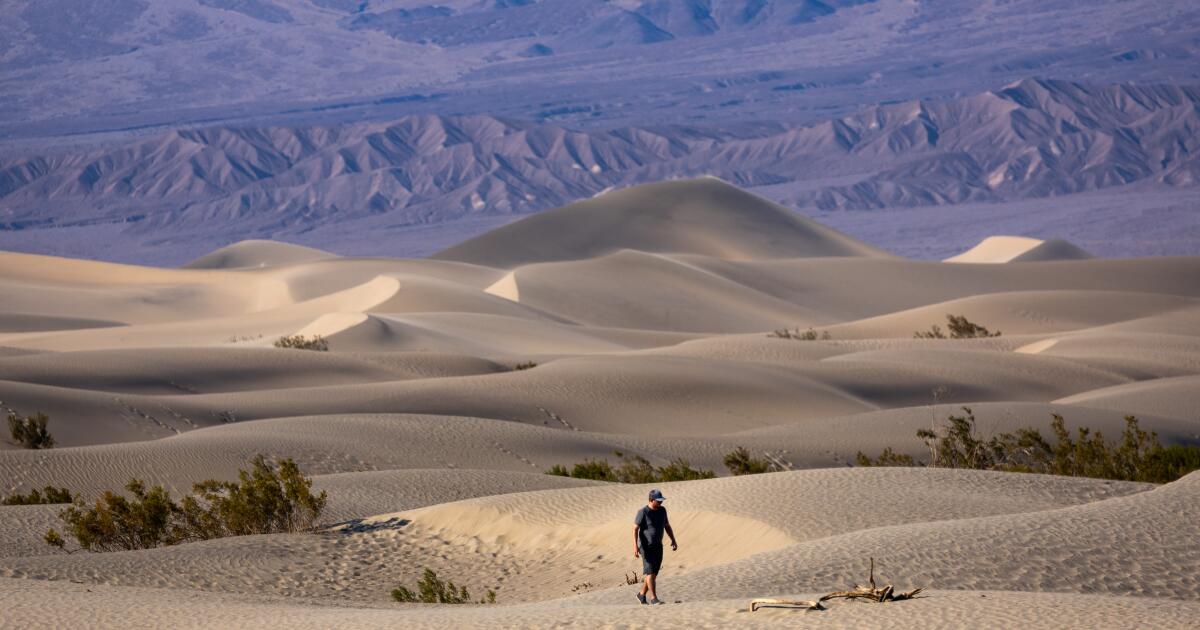
As temperatures swelled to 128 degrees, Death Valley National Park rangers got a call that a group of six motorcyclists were in distress. All available medics rushed to the scene, and rangers dispatched the park’s two ambulances.
It was an “all-hands-on-deck call,” said Spencer Solomon, Death Valley National Park’s emergency medical coordinator. The superheated air was too thin for an emergency helicopter to respond, but the team requested mutual aid from nearby fire departments.
They arrived Saturday to find one motorcyclist unresponsive, and medics labored unsuccessfully to resuscitate him. Another rider who had fallen unconscious was loaded into an ambulance, where emergency medical technicians attempted to rapidly cool the victim with ice as they transported him to an intensive care unit in Las Vegas. The four other motorcyclists were treated at the site and released.
With record heat blanketing California and much of the West recently, Death Valley has hit at least 125 degrees every day since the Fourth of July, and that streak isn’t likely to change until the weekend, according to the National Weather Service.
Tourist Dave Hsu, left, feigns a chill as friend Tom Black takes a photograph at the Furnace Creek Visitor Center’s digital thermometer.
Extreme heat is both one of Death Valley’s greatest intrigues and its most serious safety concern. It’s not uncommon for a few people to die in the park from heatstroke in any given summer.
Located 200 feet below sea level and surrounded by steep, towering mountain ranges that trap heat, the valley is consistently among the hottest places on Earth.
In the summer, international travelers often schedule their trips without considering the weather. (All six of the men who fell victim to extreme temperatures near Badwater Basin on Saturday were from Germany.)
But even Southern California residents who are familiar with Death Valley’s hellish reputation will trek to the park just to experience the otherworldly heat.
“In L.A., people said, ‘No, don’t go out there; you’re crazy,’” said Nick Van Schaick, who visited the park early this week. He had spent the night in the nearby town of Beatty, Nev., then drove into the park at the crack of dawn Tuesday. “I don’t know. … There’s something compelling about this landscape.”
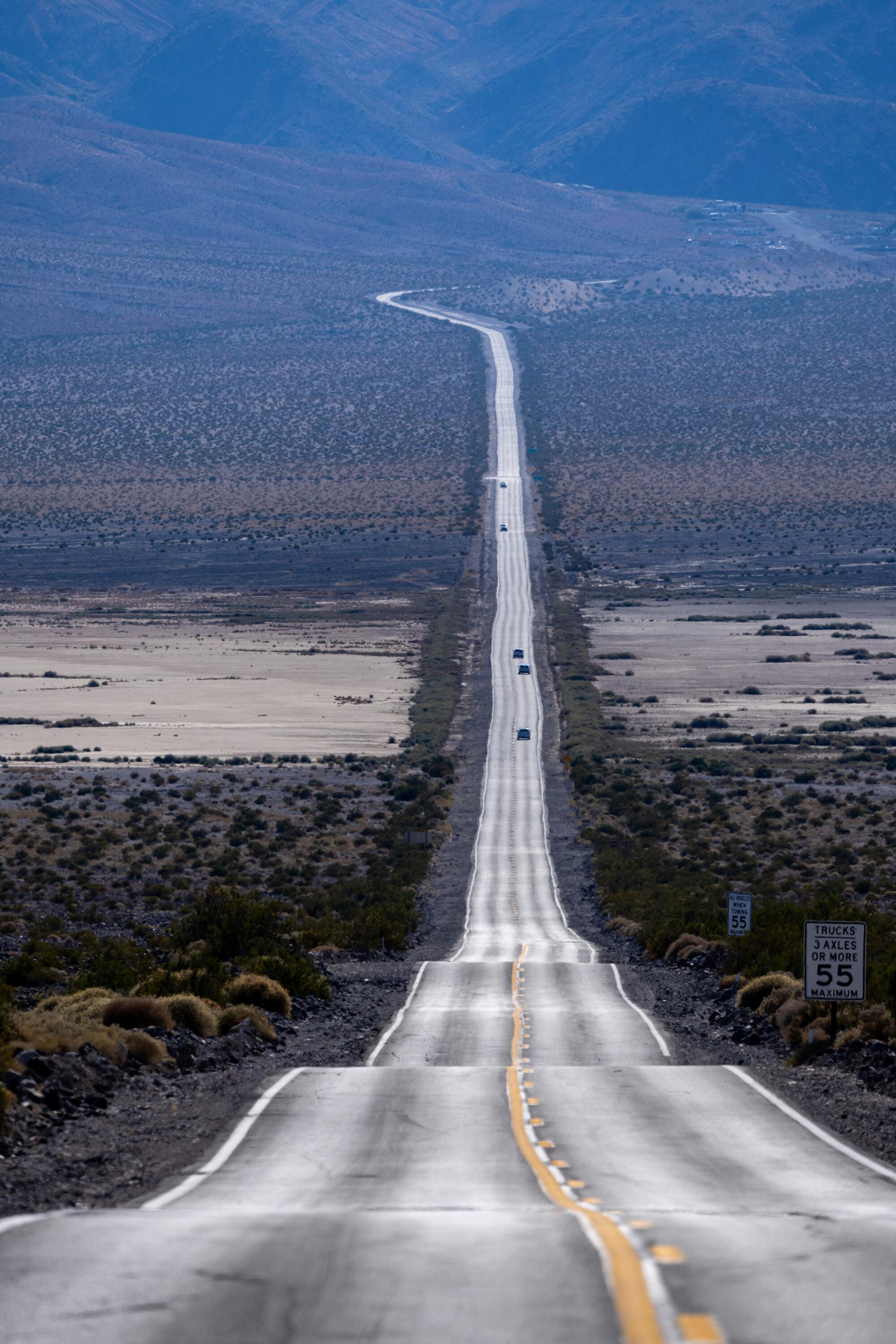
Visitors to Death Valley National Park drive in and out of the park on Highway 190 through the Panamint Valley, where temperatures were as high as 125 degrees recently.
Virtually all heat-related deaths are preventable, experts say, but what makes heat so dangerous is that it sneaks up on its victims.
The risk of Death Valley’s heat seems painfully obvious. It’s hard to miss the dozens of “Heat kills” signs throughout the park, and stepping out of a car there for the first time feels like sticking your face in an opened oven. Within seconds, your eyes begin to burn and your lips crack. Your skin feels completely dry — even though you’re sweating profusely, the sweat evaporates almost instantaneously.
But one of the first symptoms people experience as their core temperature begins to rise is confusion, which can inhibit a person’s ability to recognize that something is wrong or understand how to save themselves.
Studies have also shown that although almost everyone understands how to prevent heat illness, too few take action to protect themselves. That’s in part because many think they are uniquely able to handle the heat when in fact they are not. In 2021, a Death Valley visitor died from heat just days after another visitor had died on the same trail.
It’s a one-two punch. Hikers ignore the symptoms of heat exhaustion because they’re excited to hike or have nowhere else to go, said Bill Hanson, an instructor for Wilderness Medical Associates International and a flight paramedic in central Texas who specializes in heat-related emergencies. Then, “when a person reaches a pretty profound state of heat exhaustion — which by itself is not a lethal condition — and they’re still in that environment, the likelihood they’ll make the right decisions and reverse the process … is reduced because they have a reduced ability to make good decisions at all.”
One of the reasons that humans are quickly overcome by extreme heat is that there’s only one route for heat to exit the body. Blood carries heat from our core to our skin, and, when the breeze is too hot to carry heat away from us, the body can release it only through the evaporation of sweat. Any of that sweat that drips to the ground or is wiped off the face is a missed opportunity to cool down.
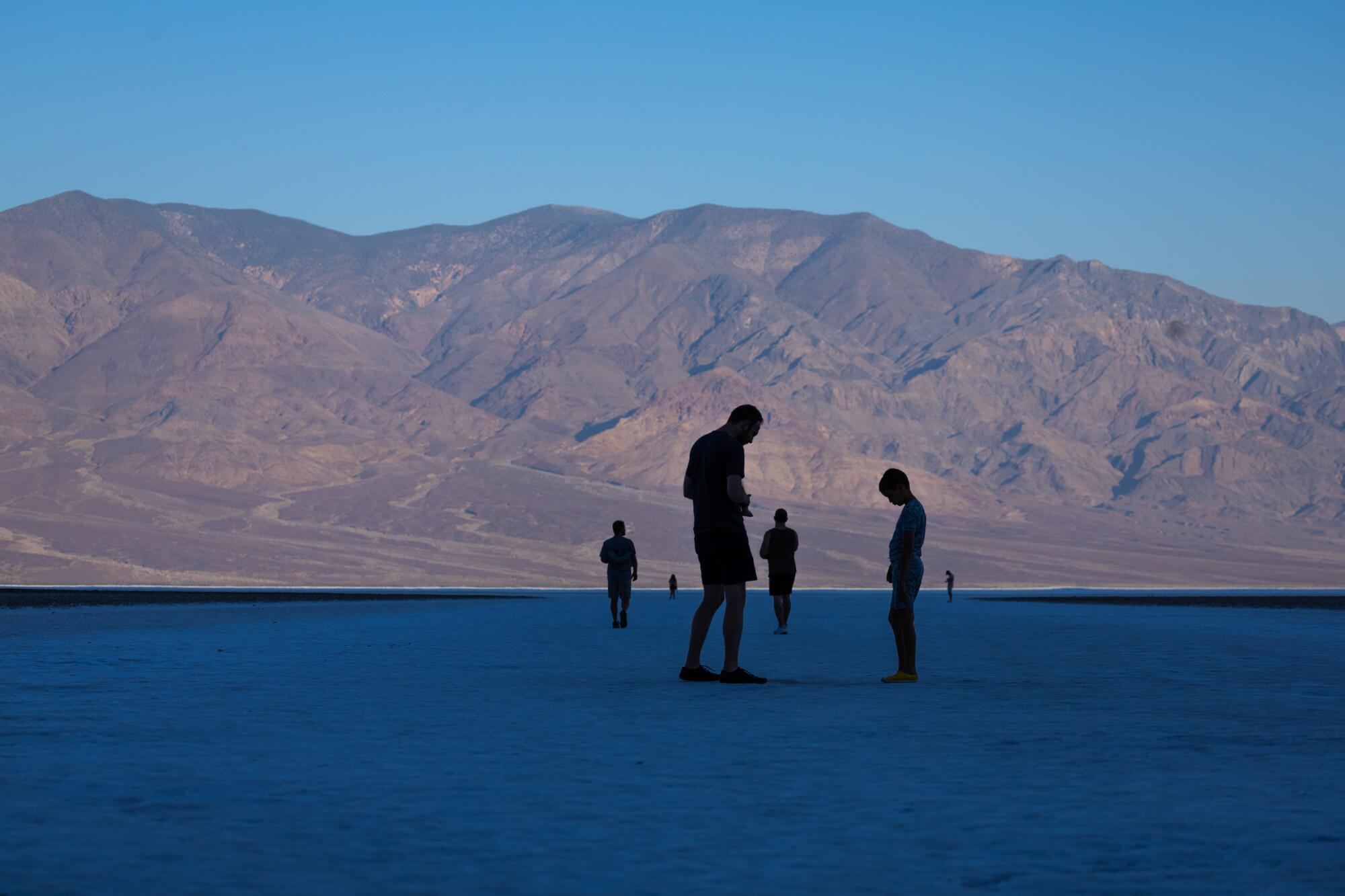
Visitors walk out onto the salt flats at Badwater Basin, taking advantage of cooler morning temperatures on a day when the mercury would rise as high as 125 degrees in Death Valley National Park.
In Death Valley, the air is so dry that sweat evaporates very easily, unlike in humid climates where the atmosphere contains more moisture. With profuse sweating, however, dehydration comes quickly. The park recommends visitors do their best to replenish lost water and drink at least a gallon a day if they’re spending time doing any physical activity outside.
But sweating and constant hydration will work only to a point.
“A 130-degree environment … there’s going to be a limited shelf life on a human body’s ability to exist in that environment without some technological support,” Hanson said.
Because of this, the park says to never hike after 10 a.m. during periods of extreme heat and recommends never straying more than five minutes away from the nearest air conditioning, whether it be in a car or building.
In the heat, sticking in groups can also save lives. While it might be difficult for a confused heat illness victim to recognize the symptoms or remember how to save themselves, friends can spot problems. In general, if you struggle to do anything that is normally easy for you — physically or mentally — stop to rest and seek cooler conditions immediately.
Muscle cramps are often the first sign the body is struggling to stay cool. They’re probably caused by a toxic concoction of dehydration, muscle fatigue and a lack of electrolytes like sodium, which are essential for chauffeuring water and nutrients throughout the body. Cramps are a sign that the body’s process for dumping heat is under stress.
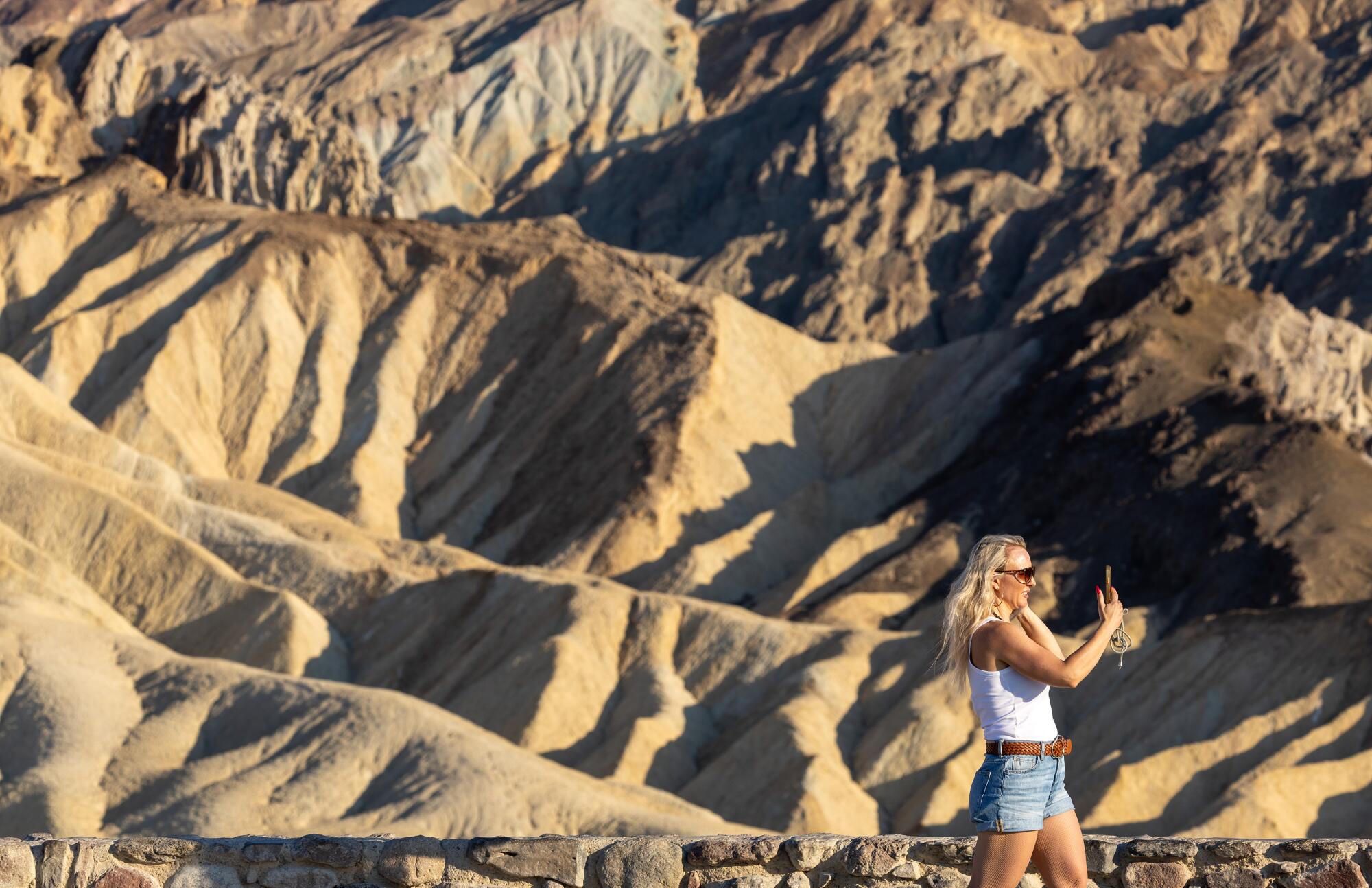
Death Valley National Park visitor Steffi Meister, from Switzerland, photographs the landscape at Zabriskie Point where temperatures were as high as 125 degrees recently.
As the body struggles, heat exhaustion starts to set in. The brain, heart and other organs become tired from working to maintain the body’s typical temperature of 98 degrees. As the body passes 101 degrees, victims can start experiencing dizziness, confusion and headaches. It’s not uncommon for them to vomit, feel weak or even faint.
As the body passes 104 degrees, the entire central nervous system — responsible for regulating heat in the first place — can no longer handle the stress of the high temperatures. It starts to shut down. The victim might get so confused and disoriented that they no longer make sense. They might not even be able to communicate. They can start to have seizures and fall into a coma.
“To me, as a park medic, if you’re unresponsive, you’re going to the hospital,” Solomon said, “because your brain is essentially cooking.”
At this point, the heat has done irreversible damage that can leave the victim disabled for years to come. If internal temperatures don’t fall quickly, death becomes a very real possibility. Organs can fail within hours, killing the victim, even after their temperature starts to drop.
Heat illness can come on within just minutes or take hours to develop. “There’s kind of a weird phenomenon where there’s two times of day where we’ll get 911 calls for people who have fallen ill” due to heat sickness, Solomon said.
One is in the middle of the afternoon, when the heat is at its worst. The other is near 11 p.m. — visitors will feel OK during the day, but get increasingly dehydrated as they continue to exert themselves. “Then, they check into their hotel room and fall ill,” Solomon said.
In some extreme cases, heatstroke can overwhelm a person so fast that muscle cramps and other symptoms of heat exhaustion don’t have time to show. The Death Valley emergency response team typically gets about two or three heat illness calls per week in the summer, with visitors experiencing symptoms across the spectrum from mild fatigue to loss of consciousness.
Heatstroke experts overwhelmingly agree on the most effective treatment: cooling the patient as fast as possible.
“The key to survival is getting their body temperature under 104 within 30 minutes of the presentation of the condition,” said Douglas Casa, a professor of kinesiology at the University of Connecticut and the chief executive of the Korey Stringer Institute, a leading voice in treating heatstrokes. “It’s 100% survivability if you do that, which is amazing because there’s not too many life-threatening emergencies in the world that have 100% survivability if treated correctly.”
The fastest way to cool a patient is a cool ice bath, experts say. Hanson said his team in Texas will fly an ice bath on a helicopter and cool the victim in the middle of the desert until their temperature stabilizes before the medics even transport them.
However, in Death Valley, getting an ice bath to victims can be nearly impossible. The hot air is so thin that the team can’t fly helicopters. Instead, they bring a body bag and cool the victim inside with ice and cool towels as they’re transported via ambulance.
Although emergencies are regular, the park says they are preventable, and if people follow park guidance, they can experience the heat safely.
“It really is a reason why some people come to visit — because this is one of the few places on Earth where you can feel what that level of heat feels like,” said supervisory park ranger Jennette Jurado. “It’s our job as park rangers to do our very best to make sure people can have these experiences and then go home safely at the end of the day and remember these experiences.”
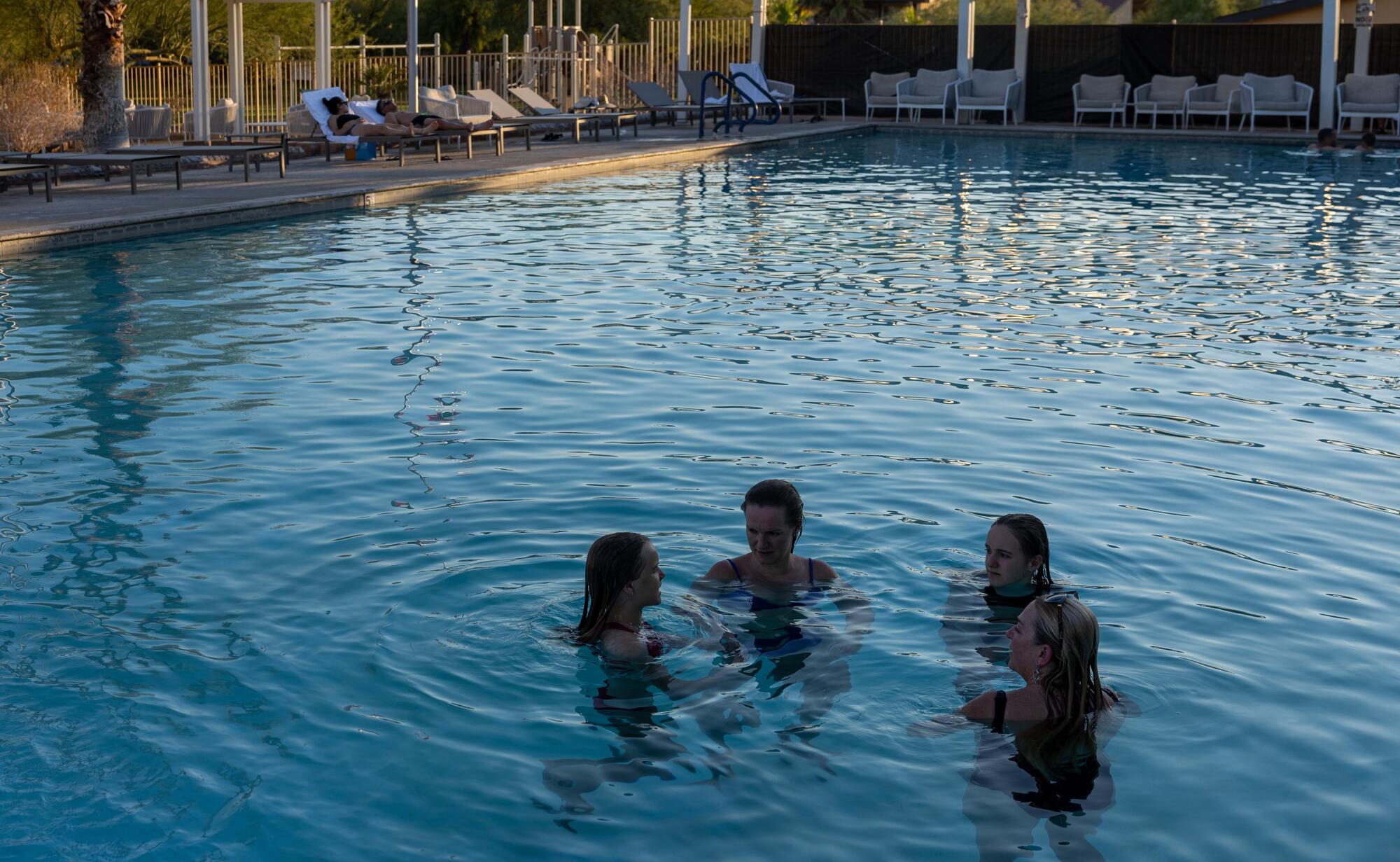
Visitors take a late-afternoon swim in the pool at Furnace Creek, where temperatures lingered in the 120s inside Death Valley National Park.
For Jurado, a safe visit looks like taking refuge in air conditioning during the hottest parts of the day and experiencing the heat in short five-minute intervals. The vast majority of visitors take this approach. If they hike at all, it’s early in the morning, and the car never leaves their sight. The rest of the day, they spend hanging at the hotel or by the pool — or they leave the park.
Although it might be possible for someone to — wrongly — convince themselves that a 90-degree heat wave in the city won’t affect them personally, it’s much harder to do that in a Death Valley heat wave.
Ironically, this makes Jurado worry more about cooler days in the park, when visitors may not be most on guard. When hikers died within days of each other a few years back, it was an unseasonably cool 105 degrees in the park.
“It’s that level of heat where people are like, ‘Oh, it’s not Death Valley hot, I can hike longer — I can take more risks,’” Jurado said.

Science
California’s last nuclear plant clears major hurdle to power on

California environmental regulators on Thursday struck a landmark deal with Pacific Gas & Electric to extend the life of the state’s last remaining nuclear power plant in exchange for thousands of acres of new land conservation in San Luis Obispo County.
PG&E’s agreement with the California Coastal Commission is a key hurdle for the Diablo Canyon nuclear plant to remain online until at least 2030. The plant was slated to close this year, largely due to concerns over seismic safety, but state officials pushed to delay it — saying the plant remains essential for the reliable operation of California’s electrical grid. Diablo Canyon provides nearly 9% of the electricity generated in the state, making it the state’s single largest source.
The Coastal Commission voted 9-3 to approve the plan, settling the fate of some 12,000 acres that surround the power plant as a means of compensation for environmental harm caused by its continued operation.
Nuclear power does not emit greenhouse gases. But Diablo Canyon uses an estimated 2.5 billion gallons of ocean water each day to absorb heat in a process known as “once-through cooling,” which kills an estimated two billion or more marine organisms each year.
Some stakeholders in the region celebrated the conservation deal, while others were disappointed by the decision to trade land for marine impacts — including a Native tribe that had hoped the land would be returned to them. Diablo Canyon sits along one of the most rugged and ecologically rich stretches of the California coast.
Under the agreement, PG&E will immediately transfer a 4,500-acre parcel on the north side of the property known as the “North Ranch” into a conservation easement and pursue transfer of its ownership to a public agency such as the California Department of Parks and Recreation, a nonprofit land conservation organization or tribe. A purchase by State Parks would result in a more than 50% expansion of the existing Montaña de Oro State Park.
PG&E will also offer a 2,200-acre parcel on the southern part of the property known as “Wild Cherry Canyon” for purchase by a government agency, nonprofit land conservation organization or tribe. In addition, the utility will provide $10 million to plan and manage roughly 25 miles of new public access trails across the entire property.
“It’s going to be something that changes lives on the Central Coast in perpetuity,” Commissioner Christopher Lopez said at the meeting. “This matters to generations that have yet to exist on this planet … this is going to be a place that so many people mark in their minds as a place that transforms their lives as they visit and recreate and love it in a way most of us can’t even imagine today.”
Critically, the plan could see Diablo Canyon remain operational much longer than the five years dictated by Thursday’s agreement. While the state Legislature only authorized the plant to operate through 2030, PG&E’s federal license renewal would cover 20 years of operations, potentially keeping it online until 2045.
Should that happen, the utility would need to make additional land concessions, including expanding an existing conservation area on the southern part of the property known as the “South Ranch” to 2,500 acres. The plan also includes rights of first refusal for a government agency or a land conservation group to purchase the entirety of the South Ranch, 5,000 acres, along with Wild Cherry Canyon — after 2030.
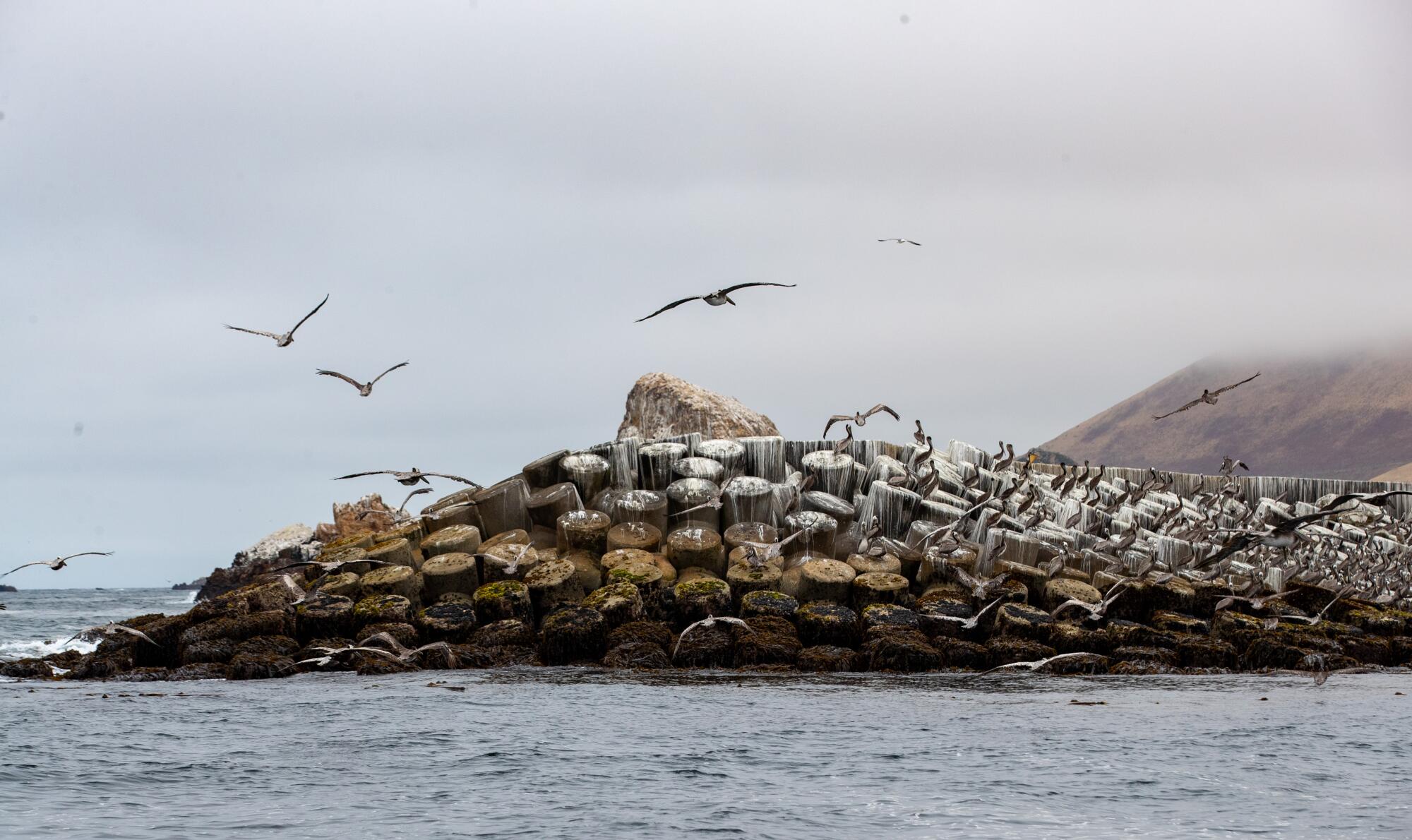
Pelicans along the concrete breakwater at Pacific Gas and Electric’s Diablo Canyon Power Plant
(Brian van der Brug/Los Angeles Times)
Many stakeholders were frustrated by the carve-out for the South Ranch, but still saw the agreement as an overall victory for Californians.
“It is a once in a lifetime opportunity,” Sen. John Laird (D-Santa Cruz) said in a phone call ahead of Thursday’s vote. “I have not been out there where it has not been breathtakingly beautiful, where it is not this incredible, unique location, where you’re not seeing, for much of it, a human structure anywhere. It is just one of those last unique opportunities to protect very special land near the California coast.”
Others, however, described the deal as disappointing and inadequate.
That includes many of the region’s Native Americans who said they felt sidelined by the agreement. The deal does not preclude tribal groups from purchasing the land in the future, but it doesn’t guarantee that or give them priority.
The yak titʸu titʸu yak tiłhini Northern Chumash Tribe of San Luis Obispo County and Region, which met with the Coastal Commission several times in the lead-up to Thursday’s vote, had hoped to see the land returned to them.
Scott Lanthrop is a member of the tribe’s board and has worked on the issue for several years.
“The sad part is our group is not being recognized as the ultimate conservationist,” he told The Times. “Any normal person, if you ask the question, would you rather have a tribal group that is totally connected to earth and wind and water, or would you like to have some state agency or gigantic NGO manage this land, I think the answer would be, ‘Hey, you probably should give it back to the tribe.’”
Tribe chair Mona Tucker said she fears that free public access to the land could end up harming it instead of helping it, as the Coastal Commission intends.
“In my mind, I’m not understanding how taking the land … is mitigation for marine life,” Tucker said. “It doesn’t change anything as far as impacts to the water. It changes a lot as far as impacts to the land.”

Montaña de Oro State Park.
(Christopher Reynolds / Los Angeles Times)
The deal has been complicated by jurisdictional questions, including who can determine what happens to the land. While PG&E owns the North Ranch parcel that could be transferred to State Parks, the South Ranch and Wild Cherry Canyon are owned by its subsidiary, Eureka Energy Company.
What’s more, the California Public Utilities Commission, which regulates utilities such as PG&E, has a Tribal Land Transfer Policy that calls for investor-owned power companies to transfer land they no longer want to Native American tribes.
In the case of Diablo Canyon, the Coastal Commission became the decision maker because it has the job of compensating for environmental harm from the facility’s continued operation. Since the commission determined Diablo’s use of ocean water can’t be avoided, it looked at land conservation as the next best method.
This “out-of-kind” trade-off is a rare, but not unheard of way of making up for the loss of marine life. It’s an approach that is “feasible and more likely to succeed” than several other methods considered, according to the commission’s staff report.
“This plan supports the continued operation of a major source of reliable electricity for California, and is in alignment with our state’s clean energy goals and focus on coastal protection,” Paula Gerfen, Diablo Canyon’s senior vice president and chief nuclear officer, said in a statement.
But Assemblymember Dawn Addis (D-Morro Bay) said the deal was “not the best we can do” — particularly because the fate of the South Ranch now depends on the plant staying in operation beyond 2030.
“I believe the time really is now for the immediate full conservation of the 12,000 [acres], and to bring accountability and trust back for the voters of San Luis Obispo County,” Addis said during the meeting.
There are also concerns about the safety of continuing to operate a nuclear plant in California, with its radioactive waste stored in concrete casks on the site. Diablo Canyon is subject to ground shaking and earthquake hazards, including from the nearby Hosgri Fault and the Shorline Fault, about 2.5 miles and 1 mile from the facility, respectively.
PG&E says the plant has been built to withstand hazards. It completed a seismic hazard assessment in 2024, and determined Diablo Canyon is safe to continue operation through 2030. The Coastal Commission, however, found if the plant operates longer, it would warrant further seismic study.
A key development for continuing Diablo Canyon’s operation came in 2022 with Senate Bill 846, which delayed closure by up to five additional years. At the time, California was plagued by rolling blackouts driven extreme heat waves, and state officials were growing wary about taking such a major source of power offline.
But California has made great gains in the last several years — including massive investments in solar energy and battery storage — and some questioned whether the facility is still needed at all.
Others said conserving thousands of acres of land still won’t make up for the harms to the ocean.
“It is unmitigatable,” said David Weisman, executive director of the nonprofit Alliance for Nuclear Responsibility. He noted that the Coastal Commission’s staff report says it would take about 99 years to balance the loss of marine life with the benefits provided by 4,500 acres of land conservation. Twenty more years of operation would take about 305 years to strike that same balance.
But some pointed out that neither the commission nor fisheries data find Diablo’s operations cause declines in marine life. Ocean harm may be overestimated, said Seaver Wang, an oceanographer and the climate and energy director at the Breakthrough Institute, a Berkeley-based research center.
In California’s push to transition to clean energy, every option comes with downsides, Wang said. In the case of nuclear power — which produces no greenhouse gas emissions — it’s all part of the trade off, he said.
“There’s no such thing as impacts-free energy,” he said.
The Coastal Commission’s vote is one of the last remaining obstacles to keeping the plant online. PG&E will also need a final nod from the Regional Water Quality Control Board, which decides on a pollution discharge permit in February.
The federal Nuclear Regulatory Commission will also have to sign off on Diablo’s extension.
Science
In search for autism’s causes, look at genes, not vaccines, researchers say

Earlier this year, Health and Human Services Secretary Robert F. Kennedy Jr. pledged that the search for autism’s cause — a question that has kept researchers busy for the better part of six decades — would be over in just five months.
“By September, we will know what has caused the autism epidemic, and we’ll be able to eliminate those exposures,” Kennedy told President Trump during a Cabinet meeting in April.
That ambitious deadline has come and gone. But researchers and advocates say that Kennedy’s continued fixation on autism’s origins — and his frequent, inaccurate claims that childhood vaccines are somehow involved — is built on fundamental misunderstandings of the complex neurodevelopmental condition.
Even after more than half a century of research, no one yet knows exactly why some people have autistic traits and others do not, or why autism spectrum disorder looks so different across the people who have it. But a few key themes have emerged.
Researchers believe that autism is most likely the result of a complex set of interactions between genes and the environment that unfold while a child is in the womb. It can be passed down through families, or originate with a spontaneous gene mutation.
Environmental influences may indeed play a role in some autism cases, but their effect is heavily influenced by a person’s genes. There is no evidence for a single trigger that causes autism, and certainly not one a child encounters after birth: not a vaccine, a parenting style or a post-circumcision Tylenol.
“The real reason why it’s complicated, the more fundamental one, is that there’s not a single cause,” said Irva Hertz-Picciotto, a professor of public health science and director of the Environmental Health Sciences Center at UC Davis. “It’s not a single cause from one person to the next, and not a single cause within any one person.”
Kennedy, an attorney who has no medical or scientific training, has called research into autism’s genetics a “dead end.” Autism researchers counter that it’s the only logical place to start.
“If we know nothing else, we know that autism is primarily genetic,” said Joe Buxbaum, a molecular neuroscientist who directs the Seaver Autism Center for Research and Treatment at the Icahn School of Medicine at Mount Sinai. “And you don’t have to actually have the exact genes [identified] to know that something is genetic.”
Some neurodevelopment disorders arise from a difference in a single gene or chromosome. People with Down syndrome have an extra copy of chromosome 21, for example, and Fragile X syndrome results when the FMR1 gene isn’t expressed.
Autism in most cases is polygenetic, which means that multiple genes are involved, with each contributing a little bit to the overall picture.
Researchers have found hundreds of genes that could be associated with autism; there may be many more among the roughly 20,000 in the human genome.
In the meantime, the strongest evidence that autism is genetic comes from studies of twins and other sibling groups, Buxbaum and other researchers said.
The rate of autism in the U.S. general population is about 2.8%, according to a study published last year in the journal Pediatrics. Among children with at least one autistic sibling, it’s 20.2% — about seven times higher than the general population, the study found.
Twin studies reinforce the point. Both identical and fraternal twins develop in the same womb and are usually raised in similar circumstances in the same household. The difference is genetic: identical twins share 100% of their genetic information, while fraternal twins share about 50% (the same as nontwin siblings).
If one fraternal twin is autistic, the chance that the other twin is also autistic is about 20%, or about the same as it would be for a nontwin sibling.
But if one in a pair of identical twins is autistic, the chance that the other twin is also autistic is significantly higher. Studies have pegged the identical twin concurrence rate anywhere from 60% to 90%, though the intensity of the twins’ autistic traits may differ significantly.
Molecular genetic studies, which look at the genetic information shared between siblings and other blood relatives, have found similar rates of genetic influence on autism, said Dr. John Constantino, a professor of pediatrics, psychiatry and behavioral sciences at the Emory University School of Medicine and chief of behavioral and mental health at Children’s Healthcare of Atlanta.
Together, he said, “those studies have indicated that a vast share of the causation of autism can be traced to the effects of genetic influences. That is a fact.”
Buxbaum compares the heritability of autism to the heritability of height, another polygenic trait.
“There’s not one gene that’s making you taller or shorter,” Buxbaum said. Hundreds of genes play a role in where you land on the height distribution curve. A lot of those genes run in families — it’s not unusual for very tall people, for example, to have very tall relatives.
But parents pass on a random mix of their genes to their children, and height distribution across a group of same-sex siblings can vary widely. Genetic mutations can change the picture. Marfan syndrome, a condition caused by mutations in the FBN1 gene, typically makes people grow taller than average. Hundreds of genetic mutations are associated with dwarfism, which causes shorter stature.
Then once a child is born, external factors such as malnutrition or disease can affect the likelihood that they reach their full height potential.
So genes are important. But the environment — which in developmental science means pretty much anything that isn’t genetics, including parental age, nutrition, air pollution and viruses — can play a major role in how those genes are expressed.
“Genetics does not operate in a vacuum, and at the same time, the impact of the environment on people is going to depend on a person’s individual genetics,” said Brian K. Lee, a professor of epidemiology and biostatistics at Drexel University who studies the genetics of developmental disorders.
Unlike the childhood circumstances that can affect height, the environmental exposures associated with autism for the most part take place in utero.
Researchers have identified multiple factors linked to increased risks of the disorder, including older parental age, infant prematurity and parental exposure to air pollution and industrial solvents.
Investigations into some of these linkages were among the more than 50 autism-related studies whose funding Kennedy has cut since taking office, a ProPublica investigation found. In contrast, no credible study has found links between vaccines and autism — and there have been many.
One move from the Department of Health and Human Services has been met with cautious optimism: even as Kennedy slashed funding to other research projects, the department in September announced a $50-million initiative to explore the interactions of genes and environmental factors in autism, which has been divided among 13 different research groups at U.S. universities, including UCLA and UC San Diego.
The department’s selection of well-established, legitimate research teams was met with relief by many autism scientists.
But many say they fear that such decisions will be an anomaly under Kennedy, who has repeatedly rejected facts that don’t conform to his preferred hypotheses, elevated shoddy science and muddied public health messaging on autism with inaccurate information.
Disagreements are an essential part of scientific inquiry. But the productive ones take place in a universe of shared facts and build on established evidence.
And when determining how to spend limited resources, researchers say, making evidence-based decisions is vital.
“There are two aspects of these decisions: Is it a reasonable expenditure based on what we already know? And if you spend money here, will you be taking money away from HHS that people are in desperate need of?” Constantino said. “If you’re going to be spending money, you want to do that in a way that is not discarding what we already know.”
Science
Contributor: New mothers are tempted by Ozempic but don’t have the data they need

My friend Sara, eight weeks after giving birth, left me a tearful voicemail. I’m a clinical psychologist specializing in postpartum depression and psychosis, but mental health wasn’t Sara’s issue. Postpartum weight gain was.
Sara told me she needed help. She’d gained 40 pounds during her pregnancy, and she was still 25 pounds overweight. “I’m going back to work and I can’t look like this,” she said. “I need to take Ozempic or something. But do you know if it’s safe?”
Great question. Unfortunately researchers don’t yet have an answer. On Dec. 1, the World Health Organization released its first guidelines on the use of GLP-1 receptor agonists such as Ozempic, generically known as semaglutide. One of the notable policy suggestions in that report is to not prescribe GLP-1s to pregnant women. Disappointingly, the report says nothing about the use of the drug by postpartum women, including those who are breastfeeding.
There was a recent Danish study that led to medical guidelines against prescribing to patients who are pregnant or breastfeeding.
None of that is what my friend wanted to hear. I could only encourage her to speak to her own medical doctor.
Sara’s not alone. I’ve seen a trend emerging in my practice in which women use GLP-1s to shed postpartum weight. The warp speed “bounce-back” ideal of body shapes for new mothers has reemerged, despite the mental health field’s advocacy to abolish the archaic pressure of martyrdom in motherhood. GLP-1s are being sold and distributed by compound pharmacies like candy. And judging by their popularity, nothing tastes sweeter than skinny feels.
New motherhood can be a stressful time for bodies and minds, but nature has also set us up for incredible growth at that moment. Contrary to the myth of spaced-out “mommy brains,” new neuroplasticity research shows that maternal brains are rewired for immense creativity and problem solving.
How could GLP-1s affect that dynamic? We just don’t know. We do know that these drugs are associated with changes far beyond weight loss, potentially including psychiatric effects such as combating addiction.
Aside from physical effects, this points to an important unanswered research question: What effects, if any, do GLP-1s have on a woman’s brain as it is rewiring to attune to and take care of a newborn? And on a breastfeeding infant? If GLP-1s work on the pleasure center of the brain and your brain is rewiring to feel immense pleasure from a baby coo, I can’t help but wonder if that will be dampened. When a new mom wants a prescription for a GLP-1 to help shed baby weight, her medical provider should emphasize those unknowns.
These drugs may someday be a useful tool for new mothers. GLP-1s are helping many people with conditions other than obesity. A colleague of mine was born with high blood pressure and cholesterol. She exercised every day and adopted a pescatarian diet. Nothing budged until she added a GLP-1 to her regimen, bringing her blood pressure to a healthy 120/80 and getting cholesterol under control. My brother, an otherwise healthy young man recently diagnosed with a rare idiopathic lymphedema of his left leg, is considering GLP-1s to address inflammation and could be given another chance at improving his quality of life.
I hope that GLP-1s will continue to help those who need it. And I urge everyone — especially new moms — to proceed with caution. A healthy appetite for nutritious food is natural. That food fuels us for walks with our dogs, swims along a coastline, climbs through leafy woods. It models health and balance for the young ones who are watching us for clues about how to live a healthy life.
Nicole Amoyal Pensak, a clinical psychologist and researcher, is the author of “Rattled: How to Calm New Mom Anxiety With the Power of the Postpartum Brain.”
-

 Alaska6 days ago
Alaska6 days agoHowling Mat-Su winds leave thousands without power
-

 Politics1 week ago
Politics1 week agoTrump rips Somali community as federal agents reportedly eye Minnesota enforcement sweep
-
Ohio1 week ago
Who do the Ohio State Buckeyes hire as the next offensive coordinator?
-

 Texas6 days ago
Texas6 days agoTexas Tech football vs BYU live updates, start time, TV channel for Big 12 title
-

 News1 week ago
News1 week agoTrump threatens strikes on any country he claims makes drugs for US
-

 World1 week ago
World1 week agoHonduras election council member accuses colleague of ‘intimidation’
-

 Washington3 days ago
Washington3 days agoLIVE UPDATES: Mudslide, road closures across Western Washington
-

 Iowa5 days ago
Iowa5 days agoMatt Campbell reportedly bringing longtime Iowa State staffer to Penn State as 1st hire


















